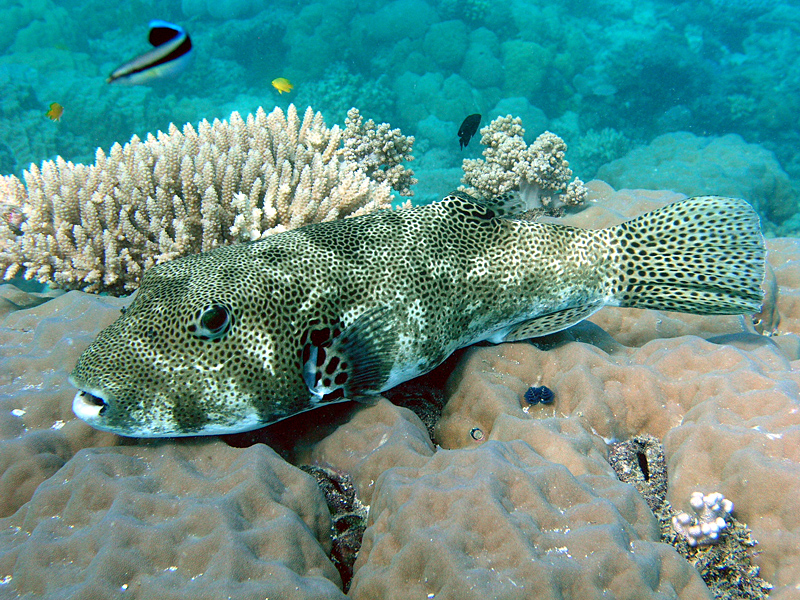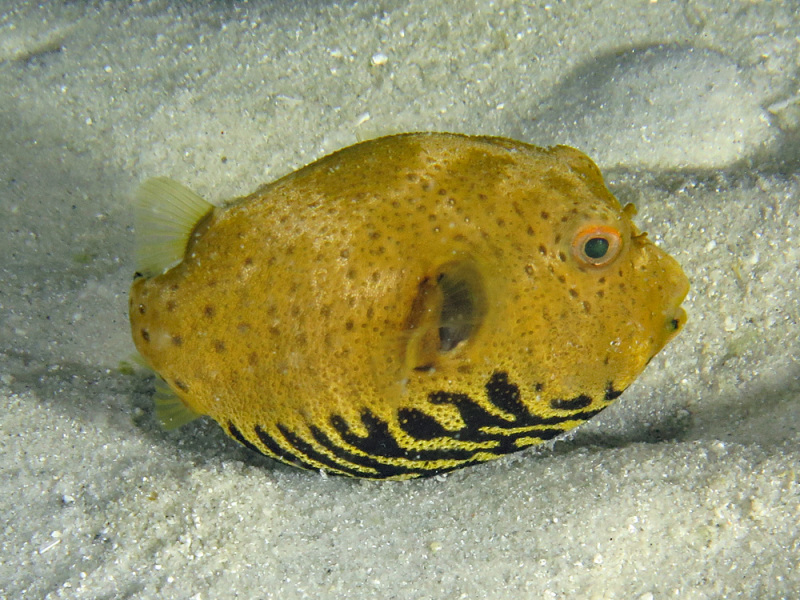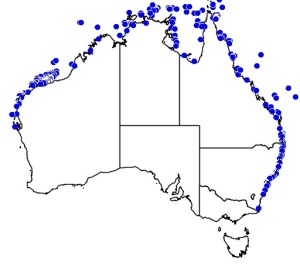
©Andy Lewis: A Starry Puffer resting on a Porites spp (massive) coral while being attended by a Common Cleaner Fish
Colours
Distinguishing features
A medium to large sized fish with large eyes, and a pale grey body covered with black dots. Swims slowly using the dorsal and anal fins.
Size
- Up to 120 cm (Standard length)
Depth range
- Depth range data is not yet available.
Synonyms
Interesting facts
- Lyle Vail (LIRS) observed a 60 cm long Starry Puffer eating an apparently healthy Crown-of-Thorns Starfish (Acanthaster planci) at two metres depth at 1800 hours on 4 October 2013 at Horseshoe Reef, Lizard Island. The puffer bit off 2-3 arms at a time and appeared to chew them for about 5 seconds before spitting out spines and other pieces of arm. This process was repeated until about half the arms were gone at which time the puffer began eating the disc and then the remaining arms. It took about 15 minutes to devour the entire COTS. Three other COTS of similar size were observed within a 10 metre radius of the one being eaten but the puffer made no attempt to eat them during the period of observations. No camera, unfortunately!
Distribution
Distribution and habitat preferences
Reef fronts, flats, and sheltered lagoonal and backreef habitats.
Can be found in most locations around the island.
Behaviour
The Starry Puffer feeds on a wide range of prey, such as worms, algae, molluscs, crustaceans, and echinoderms. The puffers have exceptionally strong, chisel like teeth which they use to render the reef in search of food. They are usually seen singly, moving slowly over the reef or resting in a hollow. There is little published information on their ecology, although they are well known for the poison (tetrodotoxin) contained in their skin and internal organs, which has caused many human fatalities.
Web resources
Danger
- unspecified - This species is poisonous and should not be eaten.
References
- Bierry, P.Y. and A. Aziz bin Hassan (1973). Comparative lethality of tissue extracts from the malaysian puffer fishes, Lagocephalus lunaris lunaris, L., L. spadiceus and Arothron stellatus, Toxicon, 11: 249-254. LIRS catalog number 90147.
- Bray, R.A., T.H. Cribb and J.-L. Justine (2010). Diploproctodaeum sp(p). (Digenea, Lepocreadiidae) in Australian and New Caledonian waters including two new species from Tetraodontiformes and new records of related species, Acta Parasitologica, 55: 313-326. LIRS catalog number 1315.
- Bray, R., A. Waeschenbach, T.H. Cribb, G.D. Weedall, P. Dyal and D.T.J. Littlewood (2009). The phylogeny of the Lepocreadioidea (Platyhelminthes, Digenea) inferred from nuclear and mitochondrial genes: implications for their systematics and evolution, Acta Parasitologica, 54: 310-329. LIRS catalog number 1280.
- View all references





